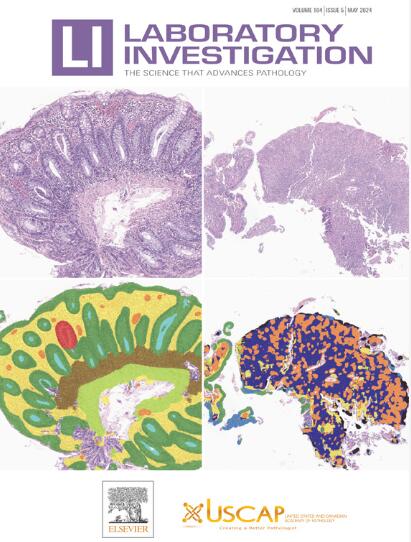基于抗体的多重图像分析:病理学家的标准分析工作流程和工具。
IF 4.2
2区 医学
Q1 MEDICINE, RESEARCH & EXPERIMENTAL
引用次数: 0
摘要
传统的组织病理学一直是疾病诊断的基石,依靠组织切片的定性或半定量视觉检查来检测病理变化。单链免疫组织化学(IHC)虽然在检测特定生物标志物方面是有效的,但往往受到其单一标记焦点的限制,这限制了其捕捉组织环境复杂性的能力。多路成像技术的引入,如多路免疫组织化学(mIHC)和多路免疫荧光(mIF),通过在单个组织切片内同时可视化多种生物标志物,已经改变了游戏规则。这些方法补充形态学与定量多标记数据和空间背景,提供细胞相互作用和疾病机制的更全面的观点。然而,来自mIHC/mIF实验的丰富数据带来了重大的分析挑战,因为大型多通道图像需要综合处理才能将原始成像数据转化为定量和有意义的信息。本文重点介绍了病理学中多重成像的标准数字图像分析工作流程,涵盖了从图像采集和预处理到细胞分割和生物标志物定量的每一步。我们将讨论支持每个步骤的通用开源工具,以指导用户选择合适的解决方案。通过概述端到端管道与具体的例子,这篇综述旨在为实践病理学家和研究人员有限的计算专业知识。它提供了实用指导和最佳实践,帮助将多重图像分析整合到常规病理工作流程和转化研究中,弥合了先进成像技术与日常诊断实践之间的差距。本文章由计算机程序翻译,如有差异,请以英文原文为准。
Antibody-Based Multiplex Image Analysis: Standard Analytical Workflows and Artificial Intelligence Tools for Pathologists
Conventional histopathology has traditionally been the cornerstone of disease diagnosis, relying on qualitative or semiquantitative visual inspection of tissue sections to detect pathological changes. Singleplex immunohistochemistry (IHC), although effective in detecting specific biomarkers, is often limited by its single-marker focus, which constrains its ability to capture the complexity of the tissue environment. The introduction of multiplexed imaging technologies, such as multiplex IHC and multiplex immunofluorescence, has been transformative, enabling the simultaneous visualization of multiple biomarkers within a single tissue section. These approaches complement morphology with quantitative multimarker data and spatial context, providing a more comprehensive view of cellular interactions and disease mechanisms. However, the rich data from multiplex IHC/multiplex immunofluorescence experiments come with significant analytical challenges, as large multichannel images require comprehensive processing to transform raw imaging data into quantitative and meaningful information. This review focuses on the standard digital image analysis workflow for multiplex imaging in pathology, covering each step from image acquisition and preprocessing to cell segmentation and biomarker quantification. We discuss the common open-source tools that support each step to guide users in selecting appropriate solutions. By outlining an end-to-end pipeline with concrete examples, this review is intended for practicing pathologists and researchers with limited computational expertise. It provides practical guidance and best practices to help integrate multiplex image analysis into routine pathology workflows and translational research, bridging the gap between advanced imaging technology and day-to-day diagnostic practice.
求助全文
通过发布文献求助,成功后即可免费获取论文全文。
去求助
来源期刊

Laboratory Investigation
医学-病理学
CiteScore
8.30
自引率
0.00%
发文量
125
审稿时长
2 months
期刊介绍:
Laboratory Investigation is an international journal owned by the United States and Canadian Academy of Pathology. Laboratory Investigation offers prompt publication of high-quality original research in all biomedical disciplines relating to the understanding of human disease and the application of new methods to the diagnosis of disease. Both human and experimental studies are welcome.
 求助内容:
求助内容: 应助结果提醒方式:
应助结果提醒方式:


